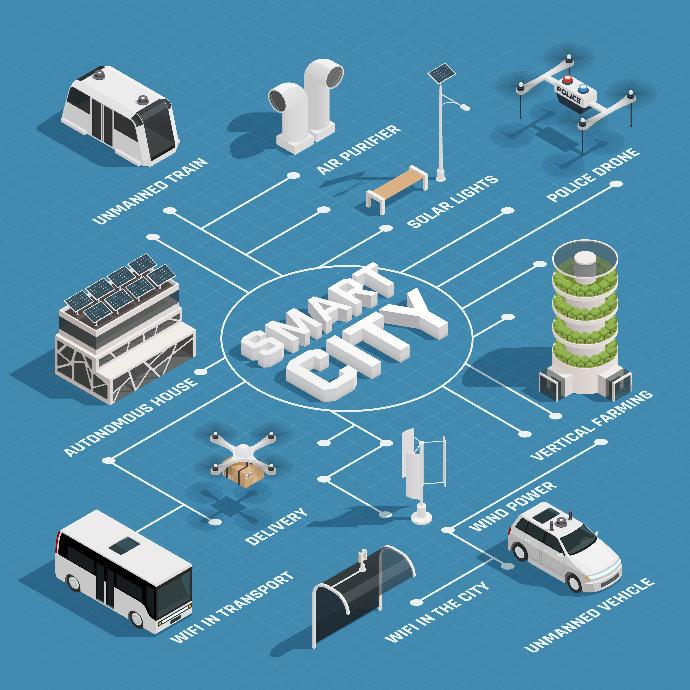By utilizing technology, countries are now able to enhance communication, transportation, and energy networks. Take Singapore and Zurich, for instance. One of the smartest cities in the world, Singapore’s automated and well connected transportation system and Zurich’s highly-efficient smart streetlights are among the many developments that the cities have done to improve their way of life and project growth and development.
As more cities pick up smart-city technology today, the core of the concept remains the same.
Smart City: The Definition
Being an ever-changing concept, there are a number of definitions one can come across on the internet.
In essence, smart cities use a combination of information and communication technologies (ICT), advanced technologies such as Artificial Intelligence (AI) and Internet of Things (IOT) to improve multiple aspects of life, from transportation to citizen welfare, infrastructure--and ideally drive the city towards higher growth and economic development by the collection of data and the implementation of technology.

WHAT MAKES A SMART CITY - THE FOUR PILLARS
The journey to a smart city isn’t overnight. It involves immense planning and understanding of purpose. The changes initiate from the ones in participation, the role of the authorities and innovation and also the four key pillars for any smart city.
Network Connectivity
Connectivity plays a pivotal role in the development of smart cities. Enhanced connectivity through devices and applications enable the governments to track real-time functions and events in the city, control the traffic, transport and sensor systems. Having a strong network for rapid data transmission and analysis helps governments manage the city more efficiently and drive towards a problem-free urban community.
Mobility
Building smart-transit systems, real-time tracking transport applications drives the city towards a smarter and more efficient infrastructure and traffic management. Possibly one of the most important developments, these are significantly seen in smart cities and help in environmentally friendly systems by reducing congestion and toxic emissions.
Cyber Security
The constant use of IT to connect within the country poses a huge amount of risk. Thus, one of the fundamental pillars of a smart city is having a secure system of data transmission, collection and analysis, to avoid any sort of intrusion and data-breach, that can have a massive impact on the functionality of smart cities and its effectiveness.
Citizen Engagement
“A city is not shaped by the people who have an important influence, but by everyone who lives or works there.” - Robert Cowin.
This becomes a really crucial foundation for having a smart city. Engaging the citizens and using technology to recognize the cause of their problems and creating solutions for them is what makes a successful smart city. The success lies in identifying the reason for developing a technology-driven city, which is for its citizens.
THE BENEFITS
The benefits of implementing smart city technologies, of course, are quite a few.
These include informed decision making, improved infrastructure, enhanced health services and a better environment. Cities make use of technologies like gunshot detectors to reduce criminal activities and can also develop faster internet services for a more interactive and efficient environment.
Furthermore, they can also stimulate workforce development and engagement through the constant development of these technologies by automating workplaces and tasks to enhance skill portfolios and reach maximum work potential.
The benefits these technologies reap are endless and extremely effective, thus making the implementation compelling for more and more governments to take up. They take a step closer to making the operations in the economy more efficient and also create opportunities for economic growth and development, to grow more competitive in today’s modernised world economy.
SMART CITIES IN THE WORLD TODAY
While more countries have gradually taken their first step towards becoming a smart city in the past few years such as India, for instance, announced its initiative to develop smart city technology in 2015, some cities have already benefited from these technologies and now rank as one of the ‘smartest’ cities in the world.
These include Singapore, Dubai, Boston, Amsterdam, Zurich and so many more. Their development towards energy conservation, water management and housing development have been evident over the past few years and definitely shown results. The global revenue for technologies of these smart cities and services is forecasted at 129 billion USD by 2021 and over 678 billion US dollars by 2028.
THE ROAD AHEAD
With constant new developments by the cities of the world for a more sustainable and smart future, the scope of “smart city technologies” remains endless. As shown, it is expected that by 2050, 68.4% of the world economy will be globalised. Today, more economies are beginning their journey towards being ‘smart.’ The future ahead holds a lot of potential and opportunities, but the world economy is destined to grow and impact its people for the better through these technological advancements. That is for sure.